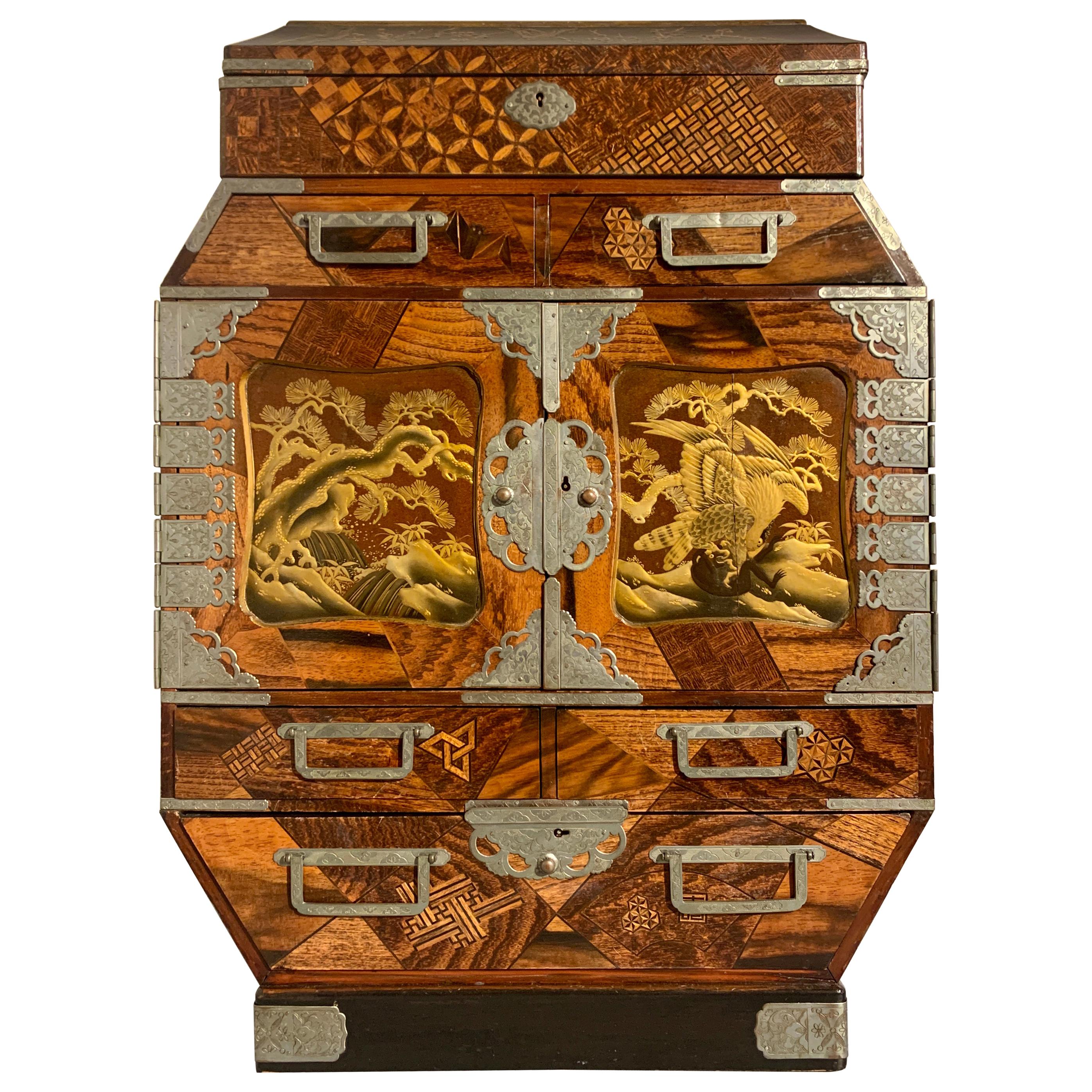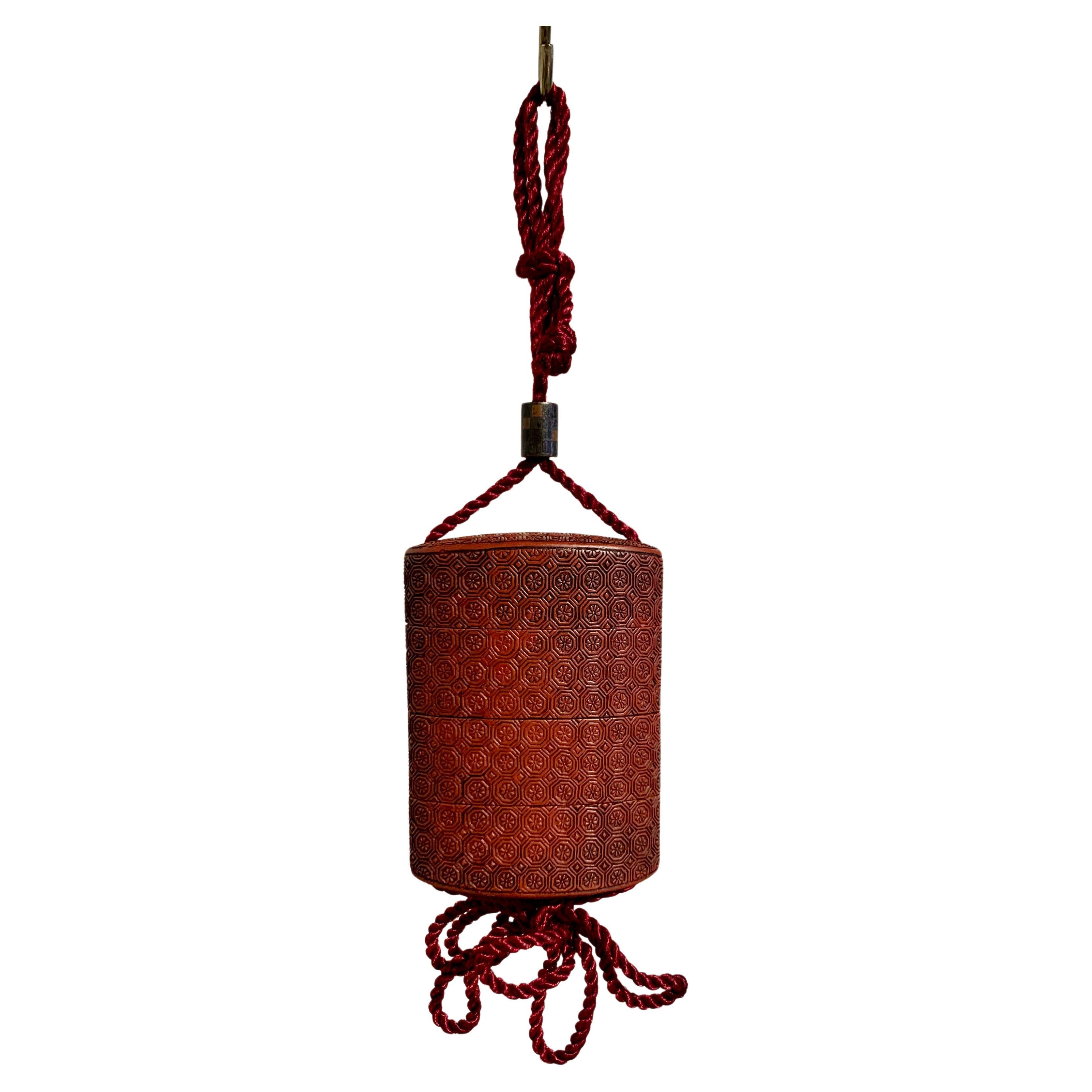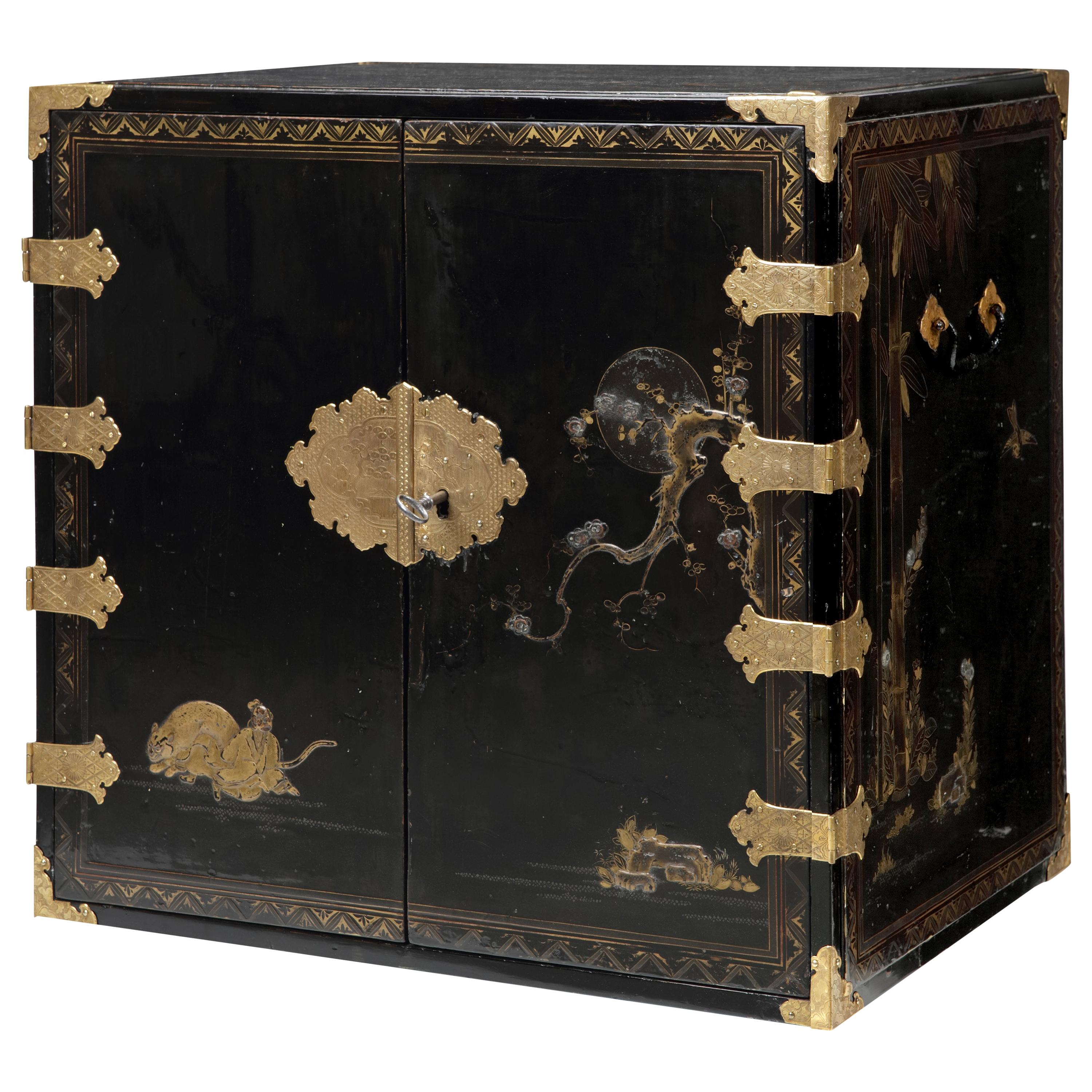Items Similar to Japanese Lacquer Display Cabinet on Stand, Meiji Period, 19th Century, Japan
Want more images or videos?
Request additional images or videos from the seller
1 of 20
Japanese Lacquer Display Cabinet on Stand, Meiji Period, 19th Century, Japan
About the Item
A spectacular Japanese lacquer and porcelain inlaid display cabinet on stand, kazaridana, Meiji Period, late 19th century, Japan.
The sumptuous kazaridana of traditional display cabinet form, with several shelves and enclosed spaces for display and storage. The cabinet decorated all over in beautiful maki-e lacquer against a dense nashiji ground and inset with blue and white Arita porcelain plaques.
The front of the cabinet of asymmetric design, with two open display shelves at staggered heights, and several doors enclosing storage areas of various shapes and sizes, including one hinged corner door, two pairs of sliding doors, and one pair of hinged doors opening to reveal a rounded inset corner shelf. A pair of drawers below complete the cabinet. All supported on a separate tall fitted stand.
The corner door decorated with a bold scene of a samurai warrior fighting a demon. This most likely depicts the warrior Watanabe no Tsuna battling the demon Ibaraki-doji at Rashomon gate, in which Watanabe no Tsuna attempts to help a young girl return home, carrying her on his back, only for the girl to turn into a demon, which he then must fight.
The top pair of sliding doors with a scene of a man playing the sho, a Japanese mouth organ, along the banks of a river with a waterfall in the background.
The bottom pair of sliding doors with a waterfall scene on one side, while a scholar lounges with his attendants on the other.
The pair of hinged doors finely decorated with a pair of fully armored samurai.
The two drawers wonderfully decorated in the kodaiji style with a stream of rushing water and various plants and grasses.
The cabinet is decorated in the round, with the top, sides, and base of the cabinet decorated with various scenes of flowers and birds, and inset with blue and white Arita porcelain plaques in the form of traditional fan. The fans painted with various floral and bird motifs, some with calligraphy and poems.
The display cabinet is set upon a separate high stand of table form, with elegant cabriole legs and a shaped apron. The stand with geometric designs in maki-e lacquer.
- Dimensions:Height: 31.25 in (79.38 cm)Width: 23.85 in (60.58 cm)Depth: 16 in (40.64 cm)
- Style:Meiji (Of the Period)
- Materials and Techniques:
- Place of Origin:
- Period:
- Date of Manufacture:circa 1880
- Condition:Repaired: The stand and some porcelain plaques with evidence of glue repairs. Touchups to the lacquer. Refinished. Wear consistent with age and use. Minor fading. In overall good condition. The stand repaired. The top with old varnish. Small losses and touchups to the lacquer, especially the edges. Some porcelain plaques with cracks and glue repairs. The hardware tarnished. See photos.
- Seller Location:Austin, TX
- Reference Number:1stDibs: LU894731204722
About the Seller
5.0
Gold Seller
These expertly vetted sellers are highly rated and consistently exceed customer expectations.
Established in 2001
1stDibs seller since 2010
305 sales on 1stDibs
Typical response time: 1 hour
- ShippingRetrieving quote...Ships From: Austin, TX
- Return PolicyA return for this item may be initiated within 7 days of delivery.
More From This SellerView All
- Large Japanese Marquetry Table Cabinet, Meiji Period, Late 19th Century, JapanLocated in Austin, TXA fine and unusually large Japanese table cabinet or jewelry chest with yosegi marquetry work and lacquer paneled doors, Meiji period, late 19th century, Japan. The oversized tab...Category
Antique 1890s Japanese Meiji Furniture
MaterialsBrass
- Japanese Carved Cinnabar Lacquer Inro, Meiji Period, late 19th c, JapanLocated in Austin, TXA good Japanese carved cinnabar three case inro with mixed metal ojime, Meiji period, late 19th century, Japan. The three case inro of standard form, comprised of three container se...Category
Antique Late 19th Century Japanese Meiji Lacquer
MaterialsSilver, Copper
- Small Japanese Lacquer Duck Incense Box, Kogo, Meiji Period, Late 19th CenturyLocated in Austin, TXAn exquisite Japanese Meiji Period small lacquer incense box, kogo, in the form of a duck or goose, late 19th century, Japan. The delicate lacquer box, known as a kogo in Japanese, ...Category
Antique Late 19th Century Japanese Meiji Lacquer
MaterialsLacquer
- Japanese Lacquer Sake Cups, Set of 3, Meiji Period, Early 20th Century, JapanLocated in Austin, TXA finely decorated set of 3 red lacquer sake cups, sakazuki, featuring views of Mt. Fuji, Meiji period, circa 1900, Japan. The lacquer sake cups, called sakazuki, of traditional p...Category
Antique Early 1900s Japanese Meiji Lacquer
MaterialsLacquer
- Japanese Maki-e Lacquer Stacking Box, Jubako, Meiji Period, JapanLocated in Austin, TXA fine and impressive Japanese gold maki-e decorated black lacquer five-tier jubako with presentation tray, two lids, and the original tomobako storage box, Meiji period, late 19th c...Category
Antique Late 19th Century Japanese Meiji Lacquer
MaterialsLacquer
- Large Japanese Lacquer Document Box, Ryoshibako, Edo/Meiji period, JapanLocated in Austin, TXA large and magnificently decorated Japanese lacquer document box, ryoshibako, signed Umeboshi/Baikyo, late Edo or early Meiji Period, mid 19th century, Japan. The large document box, ryoshibako, of tall, rectangular shape with rounded corners, and fitted with an inrobuta (flush-fitting) cover with beveled edges. The exterior of this exquisite box is decorated all over with fifteen different raised reserves shaped as uchiwa (paddle) fans against a lush and intricate krikane ground imitating shagreen. The uchiwa shaped reserves all of takamaki-e, and exquisitely painted with designs of animals, flowers, and landscapes in silver, gold, maki-e, hiramaki-e, and takamaki-e, with kirikane, nashiji, and polychrome embellishments, upon gold lacquer fudame grounds. The interior of the lid is nothing short of spectacular, featuring a large design of a magnificent and beautifully detailed rooster and hen with chicks gathered around a lazy stream. Large stalks of chrysanthemum bloom behind them. All against an ethereal nashiji ground. The cover of the box features five reserves: 1. Three minogame (turtles with long tails), symbolizing longevity 2. "Narihira Crossing the Sumida" from The Tales of Ise...Category
Antique 1860s Japanese Meiji Lacquer
MaterialsSoftwood, Lacquer
You May Also Like
- Japanese Lacquer Meiji Period Cabinet on Stand, circa 1890Located in Brighton, SussexA exquisite, fine quality Meiji period (1868-1912) Japanese black lacquer cabinet on stand with wonderful scrolling gilded decoration. H...Category
Antique Late 19th Century Japanese Japonisme Lacquer
MaterialsLacquer
- Antique Japanese Export Lacquer Bamboo Stick StandLocated in Brea, CAAntique Japanese export lacquer and gilt bamboo stick stand, see more pictures, 46'' x 27.5'' x 10''.Category
Early 20th Century Japanese Meiji Lacquer
MaterialsBamboo
- Rare Charming 17th Century Japanese Lacquer Cabinet with Gilt-Bronze MountsLocated in Amsterdam, NLA fine Japanese pictoral style lacquer cabinet with gilt-metal mounts Kyoto, Edo period, 1670-1690 Decorated in Japanese relief lacquer work, black lacquer ground decorated...Category
Antique Late 17th Century Japanese Furniture
MaterialsBronze
- 17th Century Japanese Export Lacquer Cabinet with Depiction the Dutch TradepostLocated in Amsterdam, NLA highly important Japanese export lacquer cabinet with depiction of the Dutch East India Company tradepost Deshima and the annual Dutch delegation on its way to the Shogun in Edo Edo period, circa 1660-1680 H. 88 x W. 100.5 x D. 54 cm This cabinet includes a later European japanned stand, but also a modern powder-coated steel frame. The latter can be designed and added to your specific needs. The sides and front of the rectangular two-door cabinet are embellished in gold and silver hiramaki-e and takamaki-e on a black roiro lacquer ground with a continuous design. The two doors depict a long procession of numerous figures travelling on foot and horseback along buildings and a pagoda into a mountainous landscape. This is the annual court journey, Hofreis, of the Dutch from Nagasaki to the Shogun’s court in Edo. Three horseback riders are dressed as Dutch merchants and a fourth figure, probably het Opperhoofd, is seen inside a palanquin, norimon. Just about to cross the bridge, two men are carrying a cabinet like the present one. Many Japanese figures on either side of the procession are engaged in various activities; some play musical instruments on board of small boats, others are fishing; figures inside buildings are depicted playing go, and farmers are tending to their rice paddocks. The upper part of the right door shows a large mansion, probably the local daimyo’s castle, with men kneeling before a man in the central courtyard. The court journey fits in with the foreign policy of the shogunate which accorded a role to the VOC alongside China, Korea, and the Ryukyu Islands who also had to pay tribute. However, the VOC employees were traders, having low status in Japan’s social hierarchy, and they were received with less deference than were the state embassies from Korea and the Ryukyu Islands. Nevertheless, the contacts with the Dutch were a welcome source of information to the Shogun about Europe and European science and technology. The left side of the cabinet depicts, in mirror image, a rare view of the artificial fan-shaped Deshima Island, the trading post for the Dutch in Japan. The island, where the Dutch flag flies, is surrounded by small Japanese boats and an anchored three-masted fluyt (cargo ship), flying Dutch flags, with on the stern the VOC monogram. On the bottom right a busy street of Nagasaki is shown, bordered by shops and leading up to the stone bridge. On the island the trees are beautifully painted, two cows can be seen, and the flagpole, all in very fine detail. Dutchmen and enslaved Malay are visible outside the buildings and two Japanese figures, probably guards, sit in a small hut in the centre. A maximum of fifteen to twenty Dutchmen lived on the island at any time and soldiers or women were not allowed. Restrictions on Deshima were tight, and the merchants were only allowed to leave the island by special permission. The Opperhoofd had to be replaced every year, and each new Opperhoofd had to make a court journey to pay tribute, present gifts, and to obtain permission to Margaret Barclay eep on trading. In the distance, many birds fly above the hills and a four-story pagoda can be seen. The right side of the cabinet is painted with other horse riders and their retinue journeying through mountains. The pair of doors to the front open to reveal ten rectangular drawers. The drawers are decorated with scenes of birds in flight and landscapes with trees and plants. The reverse of the left door with two thatched buildings, one with a ladder, underneath a camelia tree with large blooms; the right door with a three-story pagoda nestled among trees and both doors with a flying phoenix, ho-oo bird. The cabinet, with elaborately engraved gilt copper mounts, hinges, lock plates and brass handles, is raised on an 18th-century English japanned wood stand. A pair of large cabinets...Category
Antique 17th Century Japanese Edo Lacquer
MaterialsCopper, Gold
- Chinese Altar Tables, 19th C. LacquerLocated in Pasadena, CAThis is an unusual pair of Late Ching Chinese cinnabar-toned coromandel lacquer small altar or side tables. The tops of the tables feature complementary incised and painted scenes from Chinese every day life. Both tables are in very good condition considering their 100+ years of use. It is unusual to find a pair of coromandel incised lacquer...Category
Antique Mid-19th Century Chinese Chinese Export Lacquer
MaterialsWood, Lacquer
- 19th Century Chinese Export Lacquer and Gilt Davenport DeskLocated in Brea, CAEarly 19th century Chinese export lacquer and gilt Davenport desk, the entire finely decorated with the typical figural landscape and foliate gilt decoration, the sloped top opening ...Category
Antique Early 19th Century Chinese Qing Lacquer
MaterialsLacquer
Recently Viewed
View AllMore Ways To Browse
Lacquer Lacquer Cabinet
White Lacquer Furniture
Lacquered Base
Pair Lacquer
Pair Of Lacquer
Century Furniture White Lacquer
Lacquer Table Design
Lacquer Table Base
Cabinets On Stands
Cabinet On Stand
Lacquer White Table
White Lacquer Table
Lacquer Table Pair
Pair Of Lacquered Tables
Blue Lacquer
Blue Lacquer Furniture
Japanese Water
Flower Display





